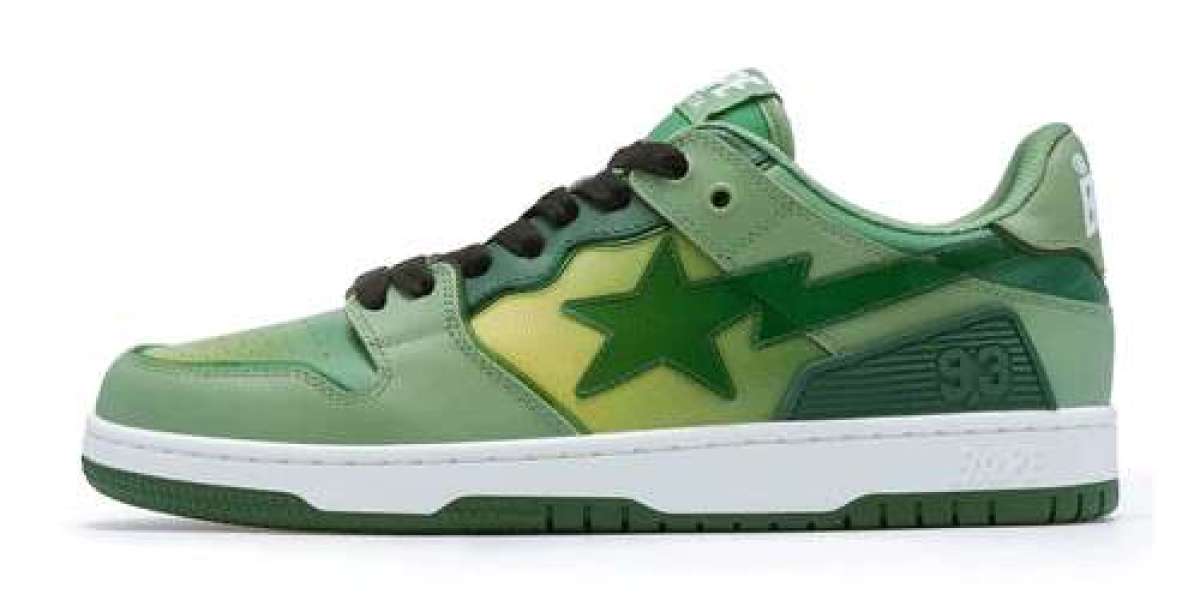In the ever-evolving world of streetwear and sneakers, few items hold the cultural weight and visual impact of the Bapesta. Born from the visionary mind of Nigo, the founder of A Bathing Ape (BAPE), the Bapesta is more than just a sneaker—it's a symbol of individuality, creativity, and the fusion of East and West in fashion.
When the Bapesta first hit the scene in the early 2000s, it made waves not only in Japan but across the global sneaker and hip-hop communities. It carried with it a bold look, a rebellious attitude, and an unapologetically loud design that instantly set it apart. While comparisons to Nike’s Air Force 1 are common, the Bapesta built its own identity through unique colorways, celebrity endorsements, and cultural significance.
Origins of the Bapesta
The Bapesta was introduced by A Bathing Ape in 2002, a Japanese streetwear brand launched by Nigo in 1993. At the time, BAPE was already well-known for its camo prints, bold branding, and collaborations with artists and musicians. The Bapesta sneaker drew immediate attention for its unmistakable resemblance to the Nike Air Force 1—but instead of the Swoosh, it featured a bold star-shaped logo called the "STA," a twist that would become its signature.
This wasn't merely a case of mimicry. In Japanese street fashion, reinterpreting Western styles has long been part of the creative process. Nigo took the DNA of American sneaker culture and infused it with the vibrancy and eccentricity of Harajuku fashion. The result was something fresh, disruptive, and undeniably influential.
Design Elements and Features
The Bapesta stands out for a variety of reasons. Its patent leather construction was a daring choice at the time, offering a glossy finish that gave the shoe a luxurious, eye-catching flair. Vibrant colorways, cartoonish aesthetics, and the exaggerated star logo on the sides made it a streetwear statement piece.
Aside from the visuals, the sneaker carried high-end street credibility. Each pair was constructed with premium materials and offered limited availability, enhancing its desirability. Logos like the "APE HEAD" or BAPE camo often adorned the insole, sole, or heel tab, branding the sneaker unmistakably.
Over time, BAPE has experimented with different iterations of the Bapesta—low tops, high tops, and even collaborations that pushed creative limits. From wild mismatched colors to metallic finishes, no idea seemed too outlandish for the Bapesta design team.
Bapesta and Hip-Hop Culture
One of the biggest catalysts for Bapesta’s global popularity was its embrace by hip-hop artists. In the early 2000s, rappers were becoming style icons, and BAPE was their go-to brand for next-level streetwear. The most iconic moment came when Pharrell Williams and Kanye West began wearing Bapestas regularly, both in music videos and on red carpets.
Their public love for the brand helped elevate it from a cult Japanese label to a globally recognized streetwear powerhouse. Kanye’s custom Bapesta, designed with a bear logo to match his “College Dropout” theme, became one of the most sought-after sneakers of the decade.
These artists weren't just wearing Bapestas—they were integrating the sneaker into their personal brands. The message was clear: if you wanted to be fashion-forward, you needed a pair of Bapestas.
Limited Editions and Collaborations
What truly cemented the Bapesta’s place in sneaker history were its collaborations. Limited-edition releases with Kaws, Marvel, DC Comics, Hello Kitty, and Undefeated brought mainstream attention and collector frenzy.
Each collaboration introduced new aesthetics, storytelling, and packaging that elevated the product beyond footwear—it became art. Collectors scrambled to get their hands on pairs that reflected pop culture icons, comic book heroes, or even Japanese anime.
These partnerships didn’t just expand BAPE’s fan base; they made the Bapesta a crossover hit in fashion, music, and entertainment circles. The scarcity of these collabs meant high resale value, turning the Bapesta into an investment piece as well.
Bapesta in the Modern Fashion Landscape
Today, Bapesta still commands respect in sneaker and streetwear culture. While the hype may have ebbed and flowed over the years, the silhouette has remained relevant thanks to strategic drops, collabs, and a devoted fan base.
Modern fashion emphasizes nostalgia and bold self-expression—two qualities the Bapesta has always embraced. Recent years have seen the brand lean into its heritage with retro-inspired releases and new iterations that appeal to both Gen Z and Millennial consumers.
Whether worn with oversized jeans, a varsity jacket, or styled high-fashion on a runway, the Bapesta adapts while keeping its essence intact. Its staying power proves that it’s more than a trend—it’s a legacy.
How to Style a Bapesta
Styling Bapestas is an exercise in balance. Because the shoes are loud by nature, they work best when allowed to be the focal point of an outfit. Pair them with minimalist pieces—plain joggers, graphic tees, or solid-colored hoodies—to let the sneakers shine.
For those more adventurous, Bapestas complement layered fits, bold prints, and vintage-inspired looks. They also pair well with other streetwear staples like BAPE shark hoodies, cargo pants, and puffer vests.
Streetwear has increasingly influenced luxury fashion, so don’t be surprised to see Bapestas styled with designer pieces. It’s all about contrast and confidence.
Bapesta vs. Air Force 1: More Than a Lookalike
Critics often reduce the Bapesta to a “copy” of the Air Force 1. While there’s no denying the structural similarity, the Bapesta has cultivated its own aesthetic and cultural relevance over the years.
The use of glossy patent leather, limited-run drops, bold colorways, and collaborations has given the Bapesta a unique flair. It’s not just a sneaker—it’s a storytelling vehicle for pop culture, youth rebellion, and self-expression.
Meanwhile, the Air Force 1 has maintained its place in sneaker history as an all-American icon. The two silhouettes may share a template, but they live in different worlds stylistically.
The Collector’s Appeal
For sneakerheads, the Bapesta is a grail item. Early 2000s pairs in good condition can fetch thousands on the resale market, especially those tied to artist collaborations or special editions.
BAPE releases tend to be limited in quantity, making it difficult to secure a pair without being quick on drop days or willing to pay premium prices after release. As with all collectible sneakers, condition, rarity, and provenance drive value.
Collectors often seek out older pairs for nostalgia and status, while newer models attract a younger crowd discovering BAPE for the first time.
The Future of the Bapesta
As BAPE continues to evolve under new creative direction, the Bapesta remains central to its identity. The sneaker represents a perfect blend of history and innovation—anchored in the past but adaptable for the future.
With fashion cycles spinning faster than ever, sneakers like the Bapesta that offer strong DNA and visual appeal are poised for longevity. Upcoming collaborations, potential tech upgrades, and expansion into new markets all suggest that the Bapesta’s best years might still lie ahead.
Final Thoughts
The Bapesta isn’t just a sneaker—it’s a cultural artifact. It embodies a moment in fashion history where Japanese streetwear challenged the global norm, where music and fashion collided, and where a star-shaped logo came to define boldness.
For anyone interested in fashion, sneakers, or cultural expression, understanding the Bapesta is essential. It’s more than a shoe—it’s a statement. Whether you're lacing up your first pair or adding to a growing collection, one thing is certain: the Bapesta isn’t going out of style anytime soon.



